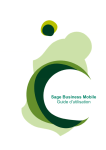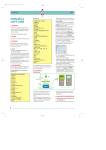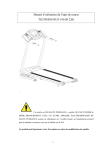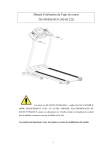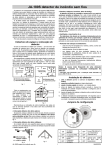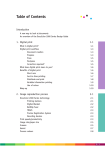Download Advanced Crosstab
Transcript
NEW TNT ADVANCED CROSSTABBING USER MANUAL 2008 Page 1 Table of Contents Categories ......................................................................................................................................................................4 Show all .....................................................................................................................................................................4 Search............................................................................................................................................................................5 Filtering ..........................................................................................................................................................................6 Other Advanced Features ..............................................................................................................................................7 Highlight Data ............................................................................................................................................................ 7 Colour Tiles................................................................................................................................................................ 8 Calculations ............................................................................................................................................................... 9 Calculation Function ............................................................................................................................................ 10 Survey Display Order............................................................................................................................................... 11 Sort: Advanced sorting ........................................................................................................................................... 11 CPT Calculation ........................................................................................................................................................... 12 Arithmetic Operators .................................................................................................................................................... 13 The “PLUS” operator ............................................................................................................................................... 13 The “minus” operator ............................................................................................................................................... 14 The “multiply” operator ............................................................................................................................................. 14 The “divide” operator ............................................................................................................................................... 14 Relational Operators .................................................................................................................................................... 15 Coding - Logical Operators .......................................................................................................................................... 16 The “And” Operator.................................................................................................................................................. 16 The “Or” Operator .................................................................................................................................................... 17 The “Not” Operator .................................................................................................................................................. 18 Combining Operators............................................................................................................................................... 18 Priority ................................................................................................................................................................. 18 Volume Coding............................................................................................................................................................. 19 Card, Column, Punch .......................................................................................................................................... 20 MNEMONICS ...................................................................................................................................................... 20 Weightings ................................................................................................................................................................... 21 Population Weight.................................................................................................................................................... 21 Household Weight ................................................................................................................................................... 21 Household Decision Maker Weight .......................................................................................................................... 21 Household Purchaser Weight .................................................................................................................................. 21 Radio Coding ............................................................................................................................................................... 22 Week Cumes ........................................................................................................................................................... 22 Day Cumes .............................................................................................................................................................. 22 Average Quarter Hours ............................................................................................................................................ 23 Page 2 Total Listenership .................................................................................................................................................... 24 Average Quarter Hour Listenership ......................................................................................................................... 24 Statistical Coding ......................................................................................................................................................... 25 MEAN & MEANZ ................................................................................................................................................. 25 MEDIAN .............................................................................................................................................................. 25 NUM .................................................................................................................................................................... 25 RAN ..................................................................................................................................................................... 25 VDIV .................................................................................................................................................................... 25 DEC (n) ............................................................................................................................................................... 25 Coding Summary ......................................................................................................................................................... 26 Special functions .......................................................................................................................................................... 29 Ntiles........................................................................................................................................................................ 29 QCodes ................................................................................................................................................................... 32 Prototypes ............................................................................................................................................................... 33 Chaid Analysis ......................................................................................................................................................... 34 Rank Format (Separate Rank Columns) ...................................................................................................................... 35 New Functions have been provided:........................................................................................................................ 36 Saving own codes.................................................................................................................................................... 37 How do I ..? .................................................................................................................................................................. 38 Code Product Usage or Purchase? ......................................................................................................................... 38 How do I code … ..................................................................................................................................................... 40 Exact Age ................................................................................................................................................................ 40 Glossary ....................................................................................................................................................................... 41 Page 3 Categories The codebook has been created in categories; by default all categories are displayed but can be deselected using the categories button. There are two ways of accessing the Category Selection window: 1. Click on CATEGORIES at the bottom of the Selection Tree. 2. Right mouse click in the Selection Tree window and select Categories. The items included in each category are differentiated by the colour of the text. E.g. Items included in the General category are coloured yellow. Show all When a specific category is selected in the Category Selection window, all other categories disappear from the Selection Tree. To bring all categories back into the Selection Tree, go back into Categories, Click on Show All and then OK. Page 4 Search Clicking on “Options”, below the search function will show the detailed search options. The user is able to save a selected set of options as default. Once the required string has been entered into the field, clicking on GO and the programme will retrieve the matching data. There are multiple search options Any keyword Enter one or more words and the search engine will find any descriptions (by default or codes if selected) that match the word(s). (Equivalent to coding „or‟) All keywords Enter more than one word where both (all) must be found in a description in order to meet the search criteria. For example in this instance Beer Heavy will only find heavy beer users, whereas in Any keyword it would find all heavy users of anything plus all beer drinkers. Exact phrase To search for an exact match. There is the option of searching for multiple “exact phrases” by entering a semi colon (;) between the phrases Start With Enter one or more words and the search engine will find a description starting with what you‟ve entered in Page 5 Filtering The program can filter on multiple items by placing a semi-colon (;) between the required items. For example: Filtering by Print; Cinema; Outdoor in the Selection Tree will collapse the display from the full listing to only sections with the words Print, Cinema, or Outdoor in them. Page 6 Other Advanced Features Highlight Data In order to quickly find data that meet certain criteria, Highlight will allow the user to specify a single or a series of criteria, e.g. index > 100 and all the rows that meet that criteria will be highlighted. The highlight colour can be changed by clicking on “Highlight Colour” and selecting a preferred colour. Page 7 Colour Tiles Colour Tiles will colour each block of data according to size. So a high index would be Red, a low index would be Blue. Any data item can be used for the tiling. Page 8 Calculations This item is valid only if there is more than one survey tabbed. A calculation can be performed on one survey against the other. Page 9 Calculation Function Perform Calculation against all o If ticked on, this will calculate all surveys in two ways: 1. Against a base: The user can select which survey is to serve as the base against all the other surveys. This is done by selecting the relevant base survey from the Primary Survey list. 2. Against a previous: If this is selected, each survey will be trended against the previous survey in the Primary Survey list. e.g. In the example below 2007A6 will automatically be trended against 2006A6. o If ticked off, this will calculate the second selected survey against the first. This option will only calculate two surveys at a time. To trend more than 2 surveys, click on More Options and select the surveys you want to trend. For example, to trend A01BP on A01AP, click on A01BP in Primary Survey, click on A01AP in Survey to Subtract and click on A01AP in Dividend. Page 10 Survey Display Order This item is valid only if there is more than one survey tabbed. Then the survey displayed and the order of display can be selected within this dialog box. Calculations created under Calculations can be removed from here. Sort: Advanced sorting Page 11 CPT Calculation In order for the user to do a CPT Calculation, they need to following the following steps: Place the target market in columns Select the required publications in rows Crosstab the run Take out data items not needed via the option “Data Items” The user then clicks on Edit / cost. A blank screen appears. The user needs to click on Add Cost. Now the user needs to click on the block with the 3 dots in to activate the latest rate cards. The user needs to know where the saved print rates are saved on either the network or locally. If the user want to use the latest rate card, it will appear at the end of the list of rate cards. o Note: If the user selected AIR (Average Issue Reader) titles, they have to select AIR rate cards. (The rates are not different for Regular Readers vs. Average Issue Readers – just a different calculation) The TNT grid will not show the CPT calculation yet. The user now has to click on “Data Items” and select Cost 1 CPT. The user either double clicks on the Cost 1 CPT option, or highlights it and use the arrow key. Page 12 Arithmetic Operators When using arithmetic operators, the result is a number. Each operand is treated as a number. It is converted to numeric on the basis that POSITIVE is 1 and NEGATIVE is 0. There are four arithmetic operators: 1. + PLUS 2. - MINUS 3. * MULTIPLY 4. / DIVIDE (DIV) The “PLUS” operator The PLUS operator adds two operands together. A respondent is counted each time he/she qualifies. The result being a number. EXAMPLE: Consider the following : COSM + STY COSM 1 + STY 0 = 1 (Read Cosmopolitan and not Style) COSM 1 + STY 1 = 2 (Read Cosmopolitan and Style) COSM 0 + STY 1 = 1 (Read Style and not Cosmopolitan) COSM 0 + STY 0 = 1 (Read neither Cosmo‟ nor Style) 4 Page 13 The “minus” operator The MINUS operator subtracts the second operand from the first operand. A respondent is counted each time he/she qualifies. The result being a number. EXAMPLE: TV-COL – TV-BW If you subtract the number of black and white television sets from the number of colour television sets, the result will give you the additional number of colour televisions to black and white televisions. NOTE: there must be a space on either side of the – sign. The “multiply” operator The MULTIPLY operator multiplies the first operand with the second operand. The result being a number. EXAMPLE: WHI*TVSETS When WHI*TVSETS is used WHI converts to 1 as it is POSITIVE. The result is a number. The “divide” operator The DIVIDE operator divides the first operand with the second operand. The result being a number. This is used primarily for radio coding. EXAMPLE: Total Community Radio Average Quarter Hour from 05:00-06:00 The code is: (Y71Y++1) / 4 / 4 = In the hour 05:00 – 06:00 there are four ¼ hours, therefore to get the average quarter hour on must divide by 4. ++ = Works the same way as “,,”. In this example it is looking at all the punch positions from Y to 1. One can not use “,,” because this is an arithmetic code. Page 14 Relational Operators The result of a relational operator is logical. Each operand must be numeric as you are comparing numbers. If either operand is not numeric it is converted to numeric on the basis that POSITIVE would be 1 and NEGATIVE 0. The relational operators are: 1. > Greater than The result is positive if the first operand is greater than the second operand. 2. 3. >= Greater than or < The result is positive if the first operand is greater than Equal to or equal to the second operand. Less than The result is positive if the first operand is less than the second operand. 4. 5. <= Less than or = The result is positive if the first operand is less than Equal to or equal to the second operand. Equal to The result is positive if the first operand is equal to the second operand. Page 15 Coding - Logical Operators Up until now, the sample coding statements have consisted of a single code. This will often be sufficient, but the software becomes most useful when joining codes to establish characteristics of target markets. For example, you might want to know not only how many people drink tea, but how many of them are men, how many of them are women, how many of the men are within a certain age group. The operators used to join codes or mnemonics are: AND OR NOT The “And” Operator The “AND” operator tells the software that both answers must have POSITIVE responses recorded eg. Females who read the Cosmopolitan. Female AND Cosmopolitan o FEM COSM (The or the AND is used to join the mnemonics) The software would then only count females who said they read the Cosmopolitan. The “AND” operator can be used to join a number of mnemonics eg. Females 16 – 24 who read the Cosmopolitan and live in Johannesburg. Female AND Age 16-24 AND Cosmopolitan AND Johannesburg In the definition “AND” they must be both one thing and the other, i.e, getting smaller. In the “AND” one universe falls within another, i.e. beauty conscious within married females. The result can never be larger than the smallest of the two. Page 16 The “Or” Operator The “OR” operator tells the software that the result is POSITIVE if either or both of the recorded responses is POSITIVE eg. People who read the Femina or the Cosmopolitan Femina OR Cosmopolitan o FEM, COSM (The, or the OR is used to join the mnemonics) The computer would then count all people who said they read the Femina or the Cosmopolitan or both the Cosmopolitan and the Femina. “OR” says they may be two things, either one or the other, getting bigger. With “OR” the computer takes both universes with the result and is never smaller that the largest of the two. Page 17 The “Not” Operator Unlike the “AND” and “OR” operators, the “NOT” operator does not tell the software how to combine the responses from two answers to get a single result. The “NOT” operator tells the software to exchange POSITIVE for NEGATIVE and vice versa. The result is that the software counts the NEGATIVE responses eg. People who do not have a television set in their households. ALL NOT TV-ANY (The NOT is used to join the mnemonics) Combining Operators Priority The software has a strict order or priority when using more that one operator i.e. using both the “AND” and the “OR” operators eg. Females between 16 and 34. Female AND (Age 16-24 OR Age 25-34) o (The and the brackets are used in this coding expression) The order of priority is firstly, BRACKETS (). In the absence of BRACKETS, the order of priority is, firstly the “AND” then the “OR”. Brackets should always be present when more than one operator is being used. Page 18 Volume Coding Volume coding is different to the normal card, column punch coding where the answer is either positive or negative. With the volume question there is a range of possible numeric answers. To cope with this range of possible answers, TELMAR uses a special type of coding namely the use of “N”, meaning any number. EXAMPLE : How many TV sets are there in your household? This particular question is a “volume” question, where the number of TV sets is the volume. There is a range of possible answers for that particular question. The coding for this question would be: M07N ……..where M07N would give the total NUMBER of TV sets in all households. How does it calculate total number of TV sets? Respondent 1 had 2 sets Respondent 2 had + 1 set Respondent 3 had + 4 sets Total number of sets =7 (ANSWER EQUALS THE NUMBER OF SETS) The coding for people who have : 2 TV Sets (M07N=2) 1-3 TV Sets (M07N>=1).(M07N<=3) (ANSWER EQUALS THE NUMBER OF PEOPLE WITH SETS) Number of TV sets can be coded using mnemonics as follows: TVSETS = total number of TV sets TVSETS=2 = no. of people with 2 TV sets (TVSETS>=1).(TVSETS<=3) = no. of people with 1-3 TV sets. Volume coding can also be used when wanting to look at exact age groups. For example if one wanted to look at those in the age group 20-30, one could code this in two ways: Page 19 Card, Column, Punch If a person replied that they were 21 years old there would be 2 columns punched, i.e. a mark at 2 in the first column and at 1 in the second column. AGE OF RESPONDENT N N COLUMN 15 16 AGE OF RESPONDENT 2 1 COLUMN 15 16 The first column is in tens and the second column is in units, i.e. 21 equals 2 X 10 + 1 Therefore, the age group 21-30 would be coded as follows: (((S15N*10)+(S16N))>=21)+(((S15N*10)+(S16N))<=30) OR IT COULD BE CODED AS FOLLOWS: (NUM (S,15,2)>=21)+(NUM (S,15,2)<=30)) MNEMONICS AGE=21 all people who are 21 years old AGE>21 all people who are over the age of 21 AGE>=21 all people 21 years or older AGE<30 all people under the age of 30 (NOTE: in AMPS only 16-29 would be included) AGE<=30 all people who are 30 years old or less ((AGE>=21).(AGE<=30)) all people who are 21-30 years old Page 20 Weightings The way that questions are asked will affect the weights used. In general there are four weights: Population Household Household Decision Maker Household Purchaser Population Weight This weight is used for questions that are directed at the individual in the household. For example: How old are you? What car do you drive? Have you read Bona in the past 6 months? Have you personally tried to lose weight by using slimming preparations in the past 12 months? Household Weight One person or a group of persons, usually but not always members of one family, who live together and whose expenditure on food and other household items is jointly managed. Boarders or lodgers may be included as members of a household provided that they have at least one main meal a day communally. Resident domestic servants are excluded and regarded as forming a household of one or more persons in their own right. The weight is used for questions that refer to the household and is used with regard to certain products such as “having a stove in the home.” Household weights can only be used on the following demographics: Geographical Location A household, due to it being all members living in that home, cannot have an age, sex or read any particular magazine or watch a particular TV station. Household Decision Maker Weight If the analysis is to be done to establish media usage or other personal demographics for ”household” questions then the Household Decision Maker Weight should be use after filtering on the HH Decision Maker (Male Head of Household or Female Housewife) Example: If one needs to find out “People with a Household Income who lives in Gauteng” The wording of the question and the purpose of the analysis determines whether analysis by Household Decision Maker Weight is meaningful. Household Purchaser Weight Any respondent of either sex who claims to be solely or partly responsible for the household purchases. These respondents weighted to households, form the basis of the values relating to household FMCG categories. Page 21 Radio Coding Radio Coding is split into quarter hour segments in the survey. Information is for an average day Monday-Sunday. The examples below pertain to the Radio Diaries. In AMPS the cards are all alpha (letters) digits – e.g. Card B. Because of the size of the Diaries there are more than 26 cards, therefore the cards are all numeric (numbers) digits – e.g. Card 2. Week Cumes A week cume calculated the maximum number of people that can be reached in one week for a particular station during a particular time period – the „net‟ listenership. Consider the following Radio 5 16:30-17:30 Mon-Fri The code is ((13067,,0),(13167,,0),(13267),(13367,,0),(13467)) A breakdown of the code The “bold” numbers above indicate the different days of the week Mon-Fri What is actually happening? The code is measuring everyone that listened at least once during the week. Regardless of how long or how often they listened, they would be counted as one person. Day Cumes A day cume gives the average number of people per day who listen to a particular time period. Consider the following Radio 5 16:30-17:30 Mon-Fri The code ((13067,,0)+(13167,,0)+(13267,,0)+(13367,,0)+(13467,,0)) DIV 5 A breakdown of the code The “bold” numbers above indicate the different days of the week Mon-Fri DIV 5 = the division of the number of days What is actually happening? The code is measuring everyone that listened each day. Regardless of how long a person listened or how many times they switched on the set during that day, they would be counted as one person. It then adds all the days together and divides that figure by the number of days (e.g. 5) to get an average per day. Page 22 Average Quarter Hours Average quarter hour figures are obtained by adding together all the quarter hour segments in a time channel and dividing by the total number of quarter hours. The result is a number, but when used with a demographic will give you the number of people who listened in the average quarter hour. EXAMPLE 1 Consider the following Radio South Africa average quarter hour on Monday from 06:00-07:00 The code is (11031++4) DIV 4 A breakdown of the code 11 = The code for Radio South Africa (Card11) 03 = Monday 0600-0900 (Column) 1 = 06:00-06:15 (Punch) ++ = The addition of the other quarter hours within the 06:00-07:00 hour 4 = Represents the last quarter hour in the 06:45-07:00 i.e. 11034 DIV 4 = In the hour 06:00-07:00 there are four quarter hours, therefore to get the average quarter hour one must divide by 4. EXAMPLE 2 Consider the following Radio South Africa Tuesday 08:00-10:00 The code is (11139++Y+11141++4) DIV 8 A breakdown of the code 11 = the code for Radio South Africa (Card 11) 13 = Tuesday 06:00-09:00 (Column) 9 = 08:00-08:15 (Punch) Note: If the column changes, e.g. from 3 to 4, then use one + and start the code again. DIV 8 = In the hour 08:00-10:00 there are eight quarter hours, therefore to get the average quarter hour one must divide by 8 Page 23 Total Listenership Total listenership measures the gross listenership of a station. It simply adds up all the times the station was listened to without taking duplication into consideration. Consider the following Radio 5 12:00-14:00 Mon-Fri The code is 13051++8+13151++8+13251++8+13351++8+13451++8 Average Quarter Hour Listenership Average listenership measures the average listenership of a station. It adds up all the times the station was listened to without taking duplication into consideration and divides it by the total number of quarter hours of the time channel. Consider the following Radio 5 12:00-14:00 Mon-Fri The code is (13051++8+13151++8+13251++8+13351++8+13451++8) DIV 40 Page 24 Statistical Coding MEAN & MEANZ MEAN & MEANZ both give you the average of a range of numbers. MEAN calculates the average based on the total sample. MEANZ calculates the average for the people who actually answered the question. For Example: MEANZ AGE (Average age) MEDIAN MEDIAN gives you the mid-point in a range of numbers. For Example: MEDIAN AGE (middle age in a range) NUM NUM is used in volumetric coding to show a number. For Example: NUM (M,07,1) will give you the number of television sets in South Africa. RAN RAN is used to combine a range of coding. For Example: AGE RAN (20,30) will give you people between the ages of 20 and 30 VDIV VDIV is used to INDEX one product code against another. For Example: BEER-H VDIV WHISKY-E will show where beer has a stronger market than whisky. DEC (n) DEC (n) - You can add the coding DEC (2) at the end of a coding statement so you can see 2 decimal places. Page 25 Coding Summary * / + GT > GE >= LT < LE <= EQ = NE <> VDiv MEANZ NUM DNUM Number RAN Numeric multiplication. Numeric division. Numeric addition. Numeric subtraction. Greater than. Greater or equal to. Less than. Less or equal to. Equal to. Not Equal. Compare audiences: e.g. if 15-44 vdiv age45+ - if you have 1000 15-44 year olds and 2000 45+ year olds, using vdiv the answer will be 0.5 divide one by another Same as mean excluding respondents with zero values. Extracts Numeric vector from CCP files Extracts floating point vector from CCP files To integrate a number Extracts respondents that fall within a range. Any All Or And Not SUM (…) (&) Double Arrow The Button will take any selected codes and create a bracketed OR statement The All button will take any selected codes and create a bracketed AND statement The OR button will add the word or to a line of coding as you enter individual codes e.g. Male OR Female The AND button will add the word AND to a line of coding as you add individual codes e.g. Female AND 12-17 The NOT button will add the word NOT to a line of coding as you add individual codes e.g. Drink Beer AND NOT Drink wine The SUM button will SUM/add all items selected to make them usable with comparison or numeric signs The Double Bracket button will bracket a full line of coding or part of the line if is selected The Open and Close Bracket buttons allow you to bracket sections of coding as you build you codes The double arrow button will replace any selected items in the editor grid with any selected items in the codebook as long as the number of items selected is the same. Page 26 ACT BIN CLUS MEAN MEDIAN MEDIANZ SOLUS SUM OF VAL VInd VMul VAUD Repeat Assigns values 1-9 for punches 1-9 in a column To see the number of items purchased rather than the number of people purchasing, only available for some surveys Similar to Num statement but extracts columns differently Mean of any numeric vector, can be filtered by a prefix within brackets e.g. (MAL)Mean(Age) Mid value in a numeric vector. May also be prefixed as Mean. Mid value in a numeric vector excluding zero values. May also be prefixed as Mean or Median. Exclusive Same as Sum Assigns given values to different punches in a column Returns the index of the 2 weighted vectors taking their universe into account: e.g.: age15-44 vind age45+: you will get a comparison index showing how they compare (e.g. if 15-44 year olds index at 150 and 45+ at 75, the answer will be 200 (Only available in monobase) Returns the product of 2 tabbed weighted vectors: multiplies audiences to compare them, only use in some specific surveys (Only available in monobase) Compare audiences as for Vdiv, but gives results as a %: e.g. if 15-44 vaud age45+ - if you have 1000 15-44 year olds and 2000 45+ year olds, using the answer will be 50 (Only available in monobase) Only use for some specific UK surveys Page 27 Data Items Audience(000) Resps %Col %Row Index Survey %Comp Audience Rank A.I.R. A.I.R. Rank %Comp Rank %Coverage %Cov Rank Index Rank %Col Rank %Row Rank %Table %Table Rank Projected Proj Rank Resps Rank 2-Sigma Tolerance 2-Sigma Tol Rank 2-Sigma % 2-Sigma % Rank This is the grossed up value based on the total Respondents to represent the total population Respondents: The actual amount of people who answered the questionnaire and answered positively to the question The percentage of the Column entry based on the row entry The percentage of the Row entry based on the Column entry A percent in relation to a norm of 100. Any value above 100 are more likely and anything below 100 is less likely Survey's code % of the audience structure Rank of the audience vs all the audiences in the Colum Average Issue Readership Rank of the AIR vs all the AIR in the column Rank of the % Comp vs all the % Comp in the column Reach in % Rank of the % Cov vs all the % Cov in the column Rank of the Index vs all the Indexes in the column Rank of the % Col vs all the % Col in the column Rank of the % Row vs all the % Row in the column Audience vs the total audience of the Table Ranks of the % Table vs all the % Table in the column Audience weighted Ranks of the Projected audience vs all the Projected audience in the column Rank of the respondents vs all the respondents results in the column 2-sigma (or two standard errors) – this means the chances are 95 out of 100 that the reported audience (e.g., the rating) would not differ from the findings of a complete census of the population by more than the +/- number reported. For example, if a 10 rating has a 2sigma of 2, and you conducted the same audience survey among 100 different samples of people, you would find a rating of between 8 and 12 (10 + or – 2) in at least 95 of them. In the remaining 5 samples you might find a rating that varies from 10 by more than +/- 2. Therefore, you can be confident of the +/- range 95 percent of the time – a 95 percent confidence level. Page 28 Special functions Ntiles Definition: In an R&F analysis – quintiles are the division of all people reached into 5 equal parts – that is, each part represent 20% of all people reached (or, all people shown in the frequency distribution). In this instance, the X (horizontal axis) is showing the quartiles, with quartile 1 being the lowest-reached group. On the Y (vertical) axis, you see the amount of frequency. Therefore, for each of the quartiles, if there were #s on the Y axis, you‟d know the amount of frequency that was obtained for each of the quartiles. If you‟re doing a print R&F in MediaPlanner, you can print a quintile analysis, showing the amount of impressions, GRPs, and other info for each quintile. Since quintile 1 is the low-exposure (low-frequency) group, they get the lowest amount of impressions, GRPS, etc, for their group. For quintile 5 (the high-exposure group), you see more GRPs and impressions. It sort of shows what you already know – people who read a lot of magazines are seeing more impressions (opportunities to see your ad) than those people who only read one or 2 magazines. Same with TV – the people in the high-exposure quintile 5 are going to get more of the GRPs and impressions in a TV R&F quintile analysis – the people who watch the most TV of all the people you‟ve reached are the people who have more opportunities to see your ad (= impressions). Page 29 1) In TNT+, if you ask for quintiles, you‟re asking to take all of the volume of a product purchased, and divide the users into equal-sized groups (most clients use quintiles for 5 groups, or terciles for 3 – heavy/ medium/ light users). The common usage is to make these Ntiles of product usage in columns in a crosstab, then media or demographic info as rows. You could find, then, for example, that heavy peanut butter purchasers, also tend to be most like to have 2+ children. OR that the heavy (high-# quintile group) users of healthy cereal also tend to be most likely to enjoy camping or hiking. To use the N-Tiles wizard, you firstly code the expression on which you wish to base the N-Tile. This can be done on the Table, Column or Row grid. Right click on the code in the row you wish to perform the N-Tiles on and a popup menu will appear. You can either click on the N-Tiles or NTilesZ menu item. Ntiles – This will work out a frequency distribution against all respondents in the survey, i.e. including those that did not answer the particular question you are analysing. NtilesZ – This will work out a frequency distribution against those respondents that answered the particular question only. It will ignore all zero respondents. The coding expression to perform the NTiles on is the uppermost text in the window. The window begins with a breakdown of 5 NTiles. You may edit this field and then click on the “Set NTiles” button. This will reset the Start and End percentages. Page 30 The percentages represent the tile you wish to extract from the coding expression. For example, 0% to 20% will extract the first 20% of Cold Drink users. You may also manually edit the percentages within the grid. However, your Start percentage may not be less that 0% and your End percentage may not be less than the Start percentage or higher than 100%. Click OK to then place your NTiles into your selected grid. The NTile function parameters are as follows: Start %, End %, and expression to NTileZ. This can be done manually as opposed to using the wizard. When tabbed the description it will include the boundaries for the N-Tile. In our example, the last column title would appear as Cold Drinks P7D 80%, 100% - 6-99. This means that for 80%-100% the values found per respondent ranged from 6 to 99. The NTile can be used as any other function to be AND‟ed and OR‟ed with. In the example, Row and Table coding expressions may also exist to be crosstabbed. Page 31 QCodes QCodes are special way of looking at attitudinal questions relating to media and product usage side by side. They may only be used as rows and they may not be mixed with other coding statements and if they are used, all rows must be defined as a Qcode. Additionally, there must be at least one column defined. The coding for the Qcode statement appears as follows: The two publications in the above example are “Beeld” and “Business Day”. Within the title you must code the different attitudes you wish to tab. Firstly, you define the title for this row followed by a double “|” separator as “||”. Thereafter, a definition for each of the attitude items to compare separated by a single “|”. Within the coding cell, enter the Qcode function with parameters as follows. The first parameter is the question asked, the second is a filter code that is AND‟ed to the attitude statements. The parameters thereafter correspond to the attitudinal titles given in the Title cell. In our example, “Beeld”, “Read Right Through” corresponds to code 6071. A successful tab of QCodes will be a grid similar to the one below: The only data items available are Audience, Respondents and Row percentage. Page 32 Prototypes The Prototype function allows the user to create a prototype vehicle/publication from another publication or pieces of various publications or various demographics. To launch the Prototypes screen, click on Edit Prototypes within the Prototypes menu item. The Prototype screen appears and automatically loads the prototype file of the selected survey. The survey combo box shows all loaded surveys in your current run. Prototypes may, at any time, be reloaded for the selected survey by clicking on the “Reload Pro File” button. You may add, delete or edit the prototypes. All mnemonics given to prototypes must be prefixed by “PROTO”. Existing prototype files will however still work. The prototypes in the grid may be tested by clicking on the “Test Prototypes” button at the bottom of the screen. All errors with prototypes will be reported and be highlighted in red. If there are no errors the AIR respondents and projected values can be seen. Remember that only mnemonics provided by Telmar for prototyping may be used here. Hence, “ALL”, and other such mnemonics are not supported in prototypes. Once completed, click on SAVE to save the prototypes. Prototypes will only save if they are all valid. To use prototypes, simply type the mnemonic of the prototype in your coding. To use Prototypes via the selection tree they appear at the first node. Page 33 Chaid Analysis CHAID (chi-square Automatic Interaction Detector) is used to simplify the process of recognizing significant natural divisions within the market. This will quickly identify niche markets. This distinguishing method facilitates immediate and accurate analysis of an extensive set of demographics categories against a desired target, CHAID: Identifies those characteristics that are key to explaining the variation in responses to a question Produces a tree diagram showing the order and magnitude of effect Could be used for example, to identify which characteristics are key to determining whether physicians are high or low prescribers of a new product Has visual impact Results can be exported to a Bitmap file for easy insertion into presentations. Simultaneously examines all of the demographics selected, their interrelationships and their predictive power of the target. This approach goes beyond a simple cross tabulation sorted by index. Telmar‟s CHAID analysis provides a user-friendly graphical representation of the statistical data. The process of creating a CHAID analysis: 1. 2. 3. Select a study Table / Base = your target market Columns = items you want to review in your CHAID analysis Note: It‟s good if you‟re going to a conference to have a set of saved „own codes‟ for 100-200 demographics or other product items for quick access during your convention. The speed is god if you keep your column limit to around 250 4. 5. No rows When completed, click on Tools, CHAID The analysis will run and display a tree style CHAID analysis by default. Page 34 Rank Format (Separate Rank Columns) An analysis can also be ranked where each column is displayed in a separate window. This format is activated via the Edit/Preferences menu – switching “Separate Rank Columns” on. In this format each window is sorted separately. Right mouse clicking on the title will sort each window into the most appropriate order. Right mouse clicking again will reverse the order. In the example below the data has been sorted by Audience. Page 35 New Functions have been provided: SOLUS results in a count of one and only one of a number of items. For example, if you want people who read only one of two publications, but not both, you can code SOLUS(PUB1,PUB2). VAUD works like VIND but operates on Audience instead of Index. In the example below there are 390000 Cape Argus and 270000 Cape Times readers, with a duplication of 143000. The SOLUS function will result in readers who read one and only one of these two publications, i.e. 374000 readers. The VAUD function will result in a ratio between the number of Cape Argus and Cape Times readers i.e. 390000/270000 = 144, or, there are 44% more readers of the Cape Argus than the Cape Times. Page 36 Saving own codes Saving Own Codes now has the option of saving only the highlighted entries in the coding grids. In order to save own codes: The user clicks on Codes and then “Save own codes” A dialog box appears which the user can either specify to only save the codes that are highlighted or to save all the codes in either Tables or Columns or Rows. o After selecting the above options, the user needs to give a description for the saved codes Page 37 How do I ..? Code Product Usage or Purchase? 1. Amount Used 2. Average Usage Take Quantity over into coding grid Take Average over into coding grid Click on * (AND) Click on * (AND) Take Light / Medium / Heavy Over Take Light / Medium / Heavy Over Only use Audience Figures Only use Audience Figures Page 38 3. Ave number used If you want to find out how many bottles a heavy consumer consume Highlight Beer Quanitity in selection tree Click on MEANZ Click on * (AND) Click on Beer Heavy Only use Audience figures Page 39 How do I code … Exact Age Open Detail Age Under Age Tree Take Exact Age over into Grid Click on RAN Type in the range of age Exact Age will be displayed Page 40 Glossary A Household decision maker weight Adults If the analysis is to be done to establish media usage A person over the age of 16 years, as defined by or other personal demographics for ”household” AMPS. questions then the Household Decision Maker Weight should be use dafter filtering on the HH Decision AMPS Maker (Male Head of Household or Female The All Media & Product Survey examines the readership, listenership, television and cinema viewing levels, as well as product & service Housewife). The wording of the question and the purpose of the analysis determines whether analysis by Household Decision Maker Weight is meaningful. consumption usage and purchase habits. Household purchaser F Any respondent of either sex who claims to be solely Frequency or partly responsible for the household purchases. The number of times, on average, that a person within These respondents weighted to households, form the the target market is supposed to have been exposed basis of the values relating to household FMCG to the advertiser‟s message. categories. Freq = Cumulative total of ratings (Total Unduplicated Household Weight Audience) The weight is used for questions that refer to the Reach% household and is used with regard to certain products H Household One person or a group of persons, usually but not such as having a stove in the home. Household weights can only be used on the following demographics: always members of one family, who live together and whose expenditure on food and other household items is jointly managed. Boarders or lodgers may be included as members of a household provided that they have at least one main meal a day communally. Resident domestic servants are excluded and regarded as forming a household of one or more 1. Household Income 2. Geographical Location 3. Living Standards Measures Housewife A housewife is the female household purchaser only. The term Housewife does not imply that she does not work. persons in their own right. I Impact The relative degree of assumed awareness, or measured ad noting, achieved by a particular creative execution in ant given medium. Page 41 Index S A percent in relation to a norm of 100. For instance, a SAARF 123 Index means that a number is 23% higher than South Afican Advertising Research Foundation. the norm. An 83 index means that a number is 17% Conducts advertising research on behalf of the below the norm. advertising industry. LSM SABRE Living Standard Measurement is one type of South African Business Research Evaluation. A segmentation tool based on wealth, access and media research survey specifically aimed at the geographic indicators. Wealth is used and business market. dependable differentiator and the AMPS variables are Sample particularly suited to this In statistics, a group of individuals, regarded as P representative of a whole population, that are selected Population for study / questioning. Also Universe. Group of persons being investigated form which some are selected in a systematic fashion Sample Area In research, the geographical area within which a to form a sample. respondent sample is obtained. Population weight This weight is used for questions that are directed at the individual in the questionnaire. The question normally includes the word PERSONALLY or YOU. Sample Error In statistics, the deviation between the observed characteristics of a sample and the characteristics of the population from which it is drawn; inherent in all For example: How old are you? samples and inversely related to sample size. Psychographics 1) The classification of people in the audience of A guaranteed position as the only ad on a page or in a media on the basis of their personality characteristics and attitudes which impact on 2) Solus commercial break. their life-styles and product purchasing behaviour W – see Life Style and demographics. Weighting A method of population segmentation based on In general, the application of ration estimation to attitudes, values, beliefs and lifestyles adjust in-tab sample data from samples so that the R weighted sample is in balance with the universe for Reach various household / persons characteristics. The number of persons within your target market, who The way that questions are asked will affect the are exposed to the advertiser‟s message at least weights used. In general there are four weights: once. This is usually reflected as a percentage and is often referred to as coverage or cover. Reach = No. of Readers / Viewers / Listeners Number of targeted consumers x100 1. Population 2. HouseholdHousehold Decision Maker 4. Household Purchaser Page 42












































